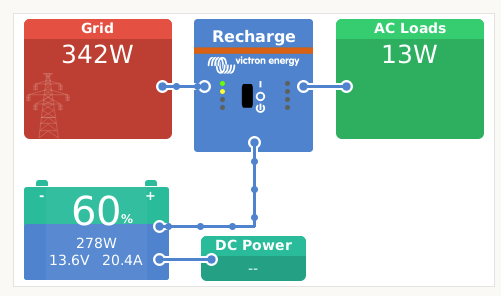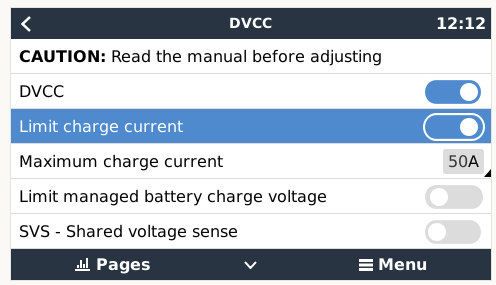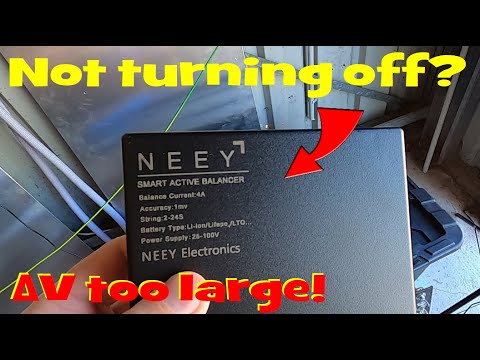Interesting, at Grid Setpoint of 50w, I now see this, 13.6v, yet BMS shows 13.32v …

Well… that would be the problem then. You have to instruct the Multi to import power, otherwise it won’t charge the battery.
There are two ways to do that. Either set the mode to Keep Batteries Charged (which internally tells the Multi to attempt to import 32kw… which just maxes it out), or… set a positive grid setpoint.
But… if the SOC is more than 5% below your MinSoc, then the auto-recharge feature automatically activates, and it brings the battery back up to the minsoc. This feature is there to prevent batteries from dropping too much below the minsoc. For example, it always drops a few % below minsoc overnight, and if you then also have an overcast day the next day, then by the next evening you might be significantly below your minsoc… which might cause you to run out of battery should there be an outage. So this feature prevents that… and you inadvertently stumbled over it.
Apologies for getting a bit animated. But I don’t like to be confused… ![]()
Further to that, if you are using this 500VA Multi only to balance batteries… then do remove the ESS assistant. You don’t need it. The BMS can tell the Multi what voltage it wants without requiring ESS (like in every off-grid system), as long as DVCC is enabled.
If however you cycle the batteries, and you therefore want the ESS assistant so you can push that energy back into the grid… then simply make sure you set a proper positive setpoint when you want it to charge.
This is in fact how we test batteries in the shop too… we don’t burn the energy off with some big heat elements and stuff… we push it back into the grid, using ESS 
@plonkster Do you perhaps know if we will be able to set the Multi’s charge current from Venus at some point?
Not a “problem”. The main system runs on Zero all the time.
… on purpose, as I don’t trust my “Frankenstein” bank whilst waiting for China to ship the next order.
The cells I’m now playing with are the 150ah cells I “removed”. So far they are behaving better and better each day, on 12v/24v systems.
What I’ve leant this last year, Keep Charged is a “no, forget that, over my dead body”. ![]()
And it complicates “other” things.
Keeping a positive Grid Setpoint, yeah, learned that when I had a DC Ripple or so from before with that, on the “old” problem bank.
DVCC is always on.
ESS assistant, yes, the MP 500va charges the cells daytime, free spare solar from the main system. At night it feeds the main house with like 150w for hours and hours. In this process, I see things, and the cells are slowly brought under control, as you always say, let the systems run for a while to balance themselves out.
Problem is, the wheels come off on 300ah 12v bank, ito balancing. ![]()
I will set the positive grid-setpoint and see how that goes, yes! Thank you.
Yeah, feeding the house makes so much more sense to “test” and play.
Methinks, learning all this with unbalanced cells, makes you think twice as hard.
On the DVCC menu there is a “lmit charge current” switch and setting that overrides the one from the BMS (if you have one). It uses the lesser of the two. Is that what you want? It’s been there since at least 2017 
Yes, here:

What I currently do is if the PV generation is low and I need to use a heavy load appliance I set ESS to ‘keep batteries charged’ to shift the load to the grid and leave the DC side to charge the pylontech’s.
I have also configured the Multiplus to only draw 5A from the grid to charge the batteries. This reduces the grid consumption.
Changing the SOC setting will either be hammering the grid or the batteries.
What I am wondering is how I could charge the batteries at 70A from the grid after an extended power outage and a very overcast day - at will or in case of an emergency.
Or be able to disable charging on the Multi.
Or should I set the multi to charge at 70A and use the ‘limit charge current’ setting disabled until I need to charge from the grid?
IF I understand your question correctly …
I control max inverter watts using NodeRd on HA, which matches the inverter max watts to the solar panel production, to spread battery use over 24h, and not draw massive loads at a time, like evenings, the max wattage is set to 500w. So when there is a big load, Eskom steps in.
In case of emergency, I will use Eskom to recharge, otherwise, I leave the system alone to sort itself out as HA also increases the SOC slowly, if there is “spare” solar power.
All other controls I tried over the years, too much “human intervention”, and one forgets to set it back.
Thanks TTT. My use case is clearly unusual and not as the system was intended to be used - so please disregard.
I do find it odd though that the Multi charger settings are not configurable from Venus. Being able to enable and disable the charger as well as set charge current would be very helpful.
Apologies for high jacking the thread.
Having started to watch Andy’s successes and tribulations, me personally able to identify with some of them, he released this video today …
The issue is the software and how it is designed to work, which threw out his 280ah bank so much that the BMS shut off, the MPPT and inverter as a result. Bad bad mojo that.
@Phil.g00 spoke about balancing whilst charging and discharging, and yeah, Neey did that in a sense, resulting in the top balancing totally out of whack.
Titbit: What I’m picking up from Andy, and he recently had to tell people not to buy too soon, is to wait for the “tests”, because things can change very fast. ![]()
JBD / QUCC BMS’s are now quite well tested, still his main BMS, and we know the shortcoming i.e. common charge/discharge. Thing is, if cells are too far out of whack, not even a 5amp active balancer can help. Saw that in one of his videos.
So, until he has actually installed the new JK BMS, I’m going to sit back with beer and popcorn and watch the show. ![]()
Conclusion I came to to date: @Louisvdw , methinks, with all that Andy has gone through so far, as I have, one of THE best ideas is to throttle the charge amps to give the BMS / balancer time to catch up when, not if, when cells get excited, by using the Delta variance between the cells. IF cells are out by like (user adjustable) 0.50v, lower the charge current immediately.
Use what Victron has already put in place, just drop the Max Charge current under DVCC, is my suggestion.
Sounds like they had a hardcoded 0.3V hysteresis which caused the balancer to remain active during discharge. Should be a simple firmware fix then.
The thing is, even those BMSes he speaks of that has “one voltage”, odds are it also has a hardcoded hysteresis, it would just be very small. The lady is not wrong. You don’t want the thing to oscillate around some voltage reading. But 0.3V is a bit wide.
Edit: When integrated into the main BMS system, which is also aware of whether the battery is charging or discharging, you can also turn the balancer off when discharging.
@plonkster , feedback, you were spot on as always.
Running the MP 500va on the 12v 300ah bank on Keep Charged, I at last see what Andy sees.
Having “changed” the BMS driver to keep going at “full speed” to 100%, the charge volts set at 3.5v per cell, as it gets damn close to 14v the MP slows down the charge and stops dead at 13.9v - 14v.
I drain the bank (150ah cells) “grid-tied” down to 30% each night, takes the WHOLE day to recharge at 273w charge, the cells stay near-perfectly balanced, after some TLC was given to these cells.
I’m smiling, thanks for the “Keep Charged” titbit. 
The balancing seldom turns on, being set at 3.45v. If the cells are balanced, and stays balanced, there is little to do.
I agree with this comment on Andy’s latest video …
Cells must just stay balanced …

